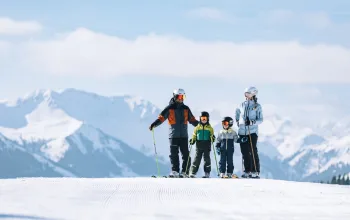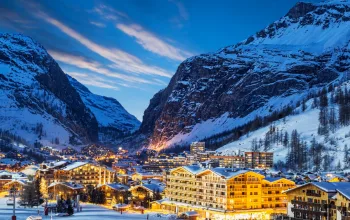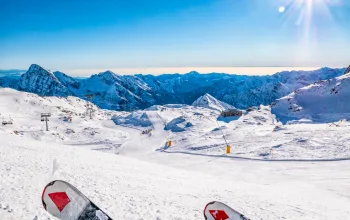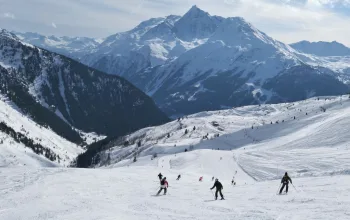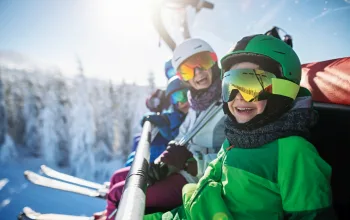Try before you fly
Having a lesson or three at a dry ski slope or indoor ski centre will save beginners – both large and small – wasting time on your expensive holiday while you learn the very basic stuff. It will build confidence, teach you how to turn and stop, and help you decide whether you prefer to ski or snowboard, so that by the time you get to the resort you’ll be good enough to enjoy yourself.
The revolving mat system at the Skiplex centres in Reading, Basingstoke and Chiswick, where you concentrate on staying in the same position while the slope moves under you is great for technique, and the set up allows the instructor to get right in close to you and your skis to teach. skiplex.co.uk
To find your nearest indoor ski centre or
dry-ski slope, see goskigoboard.org.uk
The long game
Short flights and lower costs can favour choosing Europe for your first family holiday. But if you can cope with the lengthy flights there are many advantages to going long-haul and holidaying in North America – not least the shared language.
Most North American resorts are fully set up for kids and families, with drop-in crèches – often at a fraction of the price of European ones – and great ski schools where the instructors speak English as a first language. The lift queues and slopes are never as busy in North America, nor as aggressive. On the other hand, the lift passes are a lot more expensive – sometimes double that of European resorts.
Top North American family resorts:
Aspen, US; Whistler, Canada
Choosing your resort
• Look for a resort with a short transfer time from the airport – even 90 minutes is a long time to be cooped up in a bus for children. Many Austrian resorts, for example, are within an hour of Innsbruck.
• Choose a beginner-friendly resort with plenty of easy terrain. That means separate nursery slopes near the main facilities, and plenty of green and gentle blue runs.
Top tip: Alpe d’Huez, France.
• Go compact. Ski boots and skis are heavy and children often get tired even walking a few hundred yards from your chalet or apartment. Ski-in, ski-out accommodation in a compact resort is the most convenient – and means much less walking with kit.
• Traffic-free resorts are preferable for obvious safety reasons – no motorised traffic means one less thing to worry about when all around you is strange and new. Top tip: Saas Fee, Switzerland.
• Choose a resort with lots of extra activities besides skiing. Even the keenest youngster will enjoy time off from the slopes for a spot of tobogganing or a husky sled ride. Top tip: Montgenevre, France.
• Don’t think you have to choose an A-List resort such as Val d’Isere or Courchevel. If you’re a beginner you’re better off in a smaller resort. These are usually significantly cheaper and have a more family-orientated atmosphere.
• First-timers should also consider less fashionable countries! Norway, for example, has several resorts that cater especially well to families with excellent, English-speaking ski schools, extensive childcare facilities, and plenty of gentle terrain.
Self-catering or catered?
Doing it yourself can undoubtedly keep the cost down, even if that means fish fingers for the kids and endless pasta for you, but skiing is tiring, and when you’re done for the day, do you really want to traipse round expensive supermarkets and then cook for your whole family? Or would you rather be sitting in front of a fire in a catered chalet – while the kids get fed their tea, and you wait for your chalet hosts to prepare a delicious four-course meal with free wine? It’s no surprise that most good family ski operators use catered chalets.
Why use a family operator?
Family specialists have spent years tailoring their products to exactly what families need, so, seriously, we recommend first-timers take advantage of all that experience…
• You can get good quality childcare with English-speaking nannies, babysitting, children’s meals, and family-friendly resorts with off-slope activities such as sleigh rides and tobogganing.
• Their chalets, too, will already be geared up to welcome young kids, with stair-gates, baby monitors, cots, highchairs and indoor and outdoor play areas.
• It’s also worth remembering that the needs of a family with babies or toddlers can be wildly different from those with teenagers. Again, the best specialists offer a wide range of clubs and activities catering for all ages, from angelic babies to sulky teenagers.
Although most resorts offer kids clubs and crèches, these are less likely to have English-speaking staff, whereas the specialist operators will. Club Med, for example, might not be budget but they are particularly good at this bit!
• Specialists will also do all the fiddly admin for you, such as arranging transfers, booking ski schools, sorting lift passes, even having your hire skis delivered to your chalet. Getting all this done in advance usually works out cheaper in money, energy and time. All you have to do is turn up at the airport.
Buy or rent?
Our advice for children is to buy clothes and rent hardware. So…
Buy: lots of layers and thermals, a scarf or snood, a good ski jacket with plenty of pockets, ski pants or salopettes, and a backpack. And a good pair of ski gloves is essential, as are goggles, sunglasses and a high-factor sunscreen. This is one time it especially pays to shop around, as you can pay a fortune for gear.
Top tip: Ski shows often have bargain rails, and shops like TK Maxx are budget-friendly.
Rent: there’s no need for beginners to buy skis, poles, boards or boots, especially for just a week. Your needs will quickly change as you improve, so save the big outlay until you’ve got your ski legs. Rental gear is well-maintained, there’s a wide range of choice to suit all abilities, and you can usually change anything that you don’t get on with.
Top tip: Get a helmet. They save lives.
Ski school / childcare
• For a more harmonious holiday, don’t try to teach your children how to ski or snowboard yourself. That’s what ski schools are for! Most have English-speaking instructors, and kids will be much happier making new friends than having mum or dad shout at them.
• Most ski schools start taking kids from age 4, but some will accept children as young as 3, especially for taster sessions. For snowboarding the minimum age is 7. Children over 12 usually find themselves in adult classes.
• Childcare is essential if you have younger kids and want to enjoy the slopes yourself. One, you’ll be happier getting in some ski miles; two, kids get tired and need downtime.
The cost of care…
A typical childcare package with Esprit Ski starts at £209 for five half-days, and works well with its Sprite ski tuition, also from £209.
A 6-day nursery service starts from £315.
Five days of supervised lunches from £85.
To avoid missing out, it’s essential to book childcare when you book your holiday.
Going independent: costs vary, of course, but Val Cenis, a family-friendly resort in France, has a crèche at about £35 per day. You can also hire resort-based nannies in resorts popular with the Brits, offering you a flexible service from £12 an hour, such as Meri Nannies in Meribel. merinannies.com
Ski school: Allow from about £32 per half-day (2hrs) or £48 for a full day (4hrs), with decent savings kicking in if you book up to a week’s worth of lessons.




